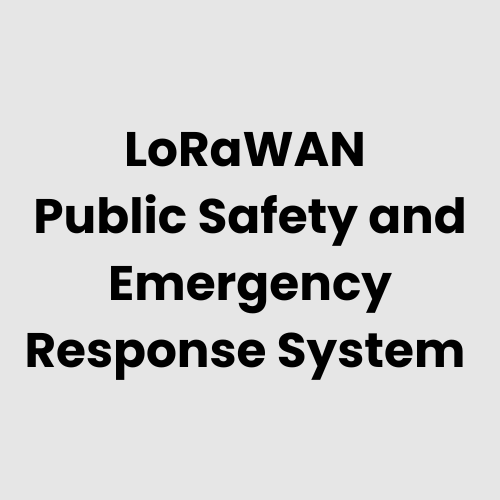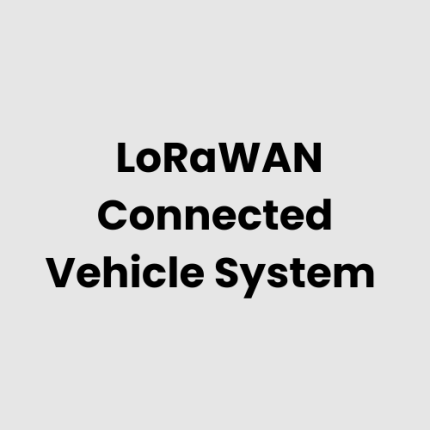Description
Technical Architecture of LoRaWAN Enabled Public Safety and Emergency Response System
A LoRaWAN-enabled Public Safety and Emergency Response System is designed to provide real-time communication, monitoring, and management during critical events. The architecture integrates sensors, gateways, and a centralized platform to deliver efficient and reliable communication for emergency responders and public safety officials. LoRaWAN’s long-range, low-power capabilities make it ideal for urban and remote area coverage.
- Sensors: These devices collect data on various parameters such as temperature, humidity, gas levels, and motion, essential for responding to environmental or hazardous incidents.
- LoRaWAN Gateways: These devices relay data from sensors to the cloud or a local server, ensuring seamless communication over long distances, even in areas with poor cellular coverage.
- Public Safety Platform: The platform serves as the central hub for data collection, analysis, and decision-making, enabling real-time alerts and coordination for emergency response teams.
Hardware of LoRaWAN Enabled Public Safety and Emergency Response System
The key hardware components of a LoRaWAN-enabled Public Safety and Emergency Response System include:
- LoRaWAN Sensors: These include environmental sensors (gas, temperature and humidity), motion detectors, and smoke detectors.
- LoRaWAN Gateways: Devices responsible for receiving data from sensors and transmitting it to the server or cloud infrastructure.
- LoRaWAN Base Stations: Located at strategic points, these stations extend the LoRaWAN network’s coverage to ensure reliable communication across the service area.
- Communication Devices: Used by emergency responders for real-time communication, ensuring seamless coordination.
- Local Servers: Used for storing and processing data, especially in remote locations where cloud connectivity may be unreliable.
- IoT Controllers: These devices manage sensor data and integrate with other emergency response systems for automated alerts and responses.
Physical Placement Considerations of Hardware
Proper placement of hardware is essential to ensure effective system performance:
- Sensors: Sensors should be placed in critical locations that require constant monitoring, such as in industrial zones, public spaces, or areas prone to natural disasters (e.g., near rivers for flood monitoring).
- Gateways and Base Stations: These devices should be installed at high points to ensure maximum range. Ideally, gateways should be placed in areas with clear line-of-sight to cover large geographic regions.
- Communication Devices: Should be readily available to emergency personnel and placed in strategic locations, such as in police and fire stations, for immediate access during emergencies.
- Local Servers: For remote areas, local servers should be positioned in secure, climate-controlled environments to ensure operational stability during disasters.
Hardware Architecture of LoRaWAN Enabled Public Safety and Emergency Response System
The hardware architecture typically consists of the following layers:
- Sensor Layer: Collects environmental and emergency-related data.
- Communication Layer: Comprises LoRaWAN gateways, base stations, and communication devices that transmit sensor data.
- Processing Layer: Encompasses local servers or cloud platforms where data is aggregated, analyzed, and acted upon.
- User Interface Layer: Provides emergency responders with a real-time dashboard that displays actionable insights, alarms, and updates for quick decision-making.
Deployment Considerations of LoRaWAN Enabled Public Safety and Emergency Response System
When deploying a LoRaWAN-enabled public safety system, the following factors should be considered:
- Coverage Area: LoRaWAN’s long-range capability allows it to cover both urban and remote areas. Understanding the geographic and demographic coverage requirements will determine the number of gateways and base stations needed.
- Reliability: Emergency response systems require high reliability, so robust hardware with backup power and failover capabilities is essential. Gateways should have redundancy to prevent data loss.
- Data Privacy and Security: LoRaWAN systems should ensure encrypted communication between devices and the server, maintaining the confidentiality of emergency data.
- Scalability: As public safety needs grow, the system must scale accordingly. LoRaWAN networks can be easily expanded to add more sensors or cover new areas.
- Environmental Conditions: Hardware must be durable and weather-resistant, especially when deployed in harsh or remote environments.
List of Relevant Industry Standards and Regulations
- LoRaWAN 1.0.3 and 1.1 Specifications
- ISO 9001:2015 – Quality Management Systems
- ISO/IEC 27001:2013 – Information Security Management Systems
- FCC Part 15 – Radio Frequency Devices
- NFPA 72 – National Fire Alarm and Signaling Code
- NIST SP 800-53 – Security and Privacy Controls for Federal Information Systems
- ISO/IEC 12207 – Systems and Software Engineering Lifecycle Processes
- IEC 61508 – Functional Safety of Electrical/Electronic/Programmable Electronic Safety-Related Systems
Local Server Version of LoRaWAN Enabled Public Safety and Emergency Response System
For areas where cloud connectivity is unreliable or where local data processing is essential, a local server version of the LoRaWAN-enabled Public Safety and Emergency Response System is ideal. This setup includes:
- Local Data Storage: Ensures that emergency data is stored locally and processed in real-time without reliance on external networks.
- Edge Computing: Provides computing resources closer to the sensors for immediate analysis, reducing latency.
- Offline Capabilities: Ensures the system remains operational during network outages by using local processing until connectivity is restored.
Cloud Integration and Data Management
In cases where cloud integration is employed, data from the sensors and gateways is transmitted securely to a cloud platform for analysis and long-term storage. The benefits include:
- Real-time Alerts: Cloud-based systems provide instant notification to emergency responders, enabling faster reaction times.
- Data Analytics: Cloud platforms use advanced analytics to assess trends, predict risks, and provide actionable insights to improve public safety.
- Scalability: Cloud infrastructure allows for easy scaling as new sensors and devices are added to the system.
- Centralized Management: Public safety officials can manage and monitor the system remotely, with data aggregation from various locations for better decision-making.
At GAO Tek Inc., we provide reliable, scalable, and secure LoRaWAN-enabled systems for public safety and emergency response. With over four decades of experience in providing cutting-edge solutions to Fortune 500 companies and government agencies, we ensure that our systems meet the highest standards of quality and performance. Our team offers expert support both remotely and on-site, guaranteeing your system remains operational during critical moments.
GAO Case Studies of LoRaWAN Enabled Public Safety and Emergency Response System
USA Case Studies
- Los Angeles, California
In Los Angeles, a LoRaWAN-based public safety system was deployed to monitor air quality and detect hazardous gas leaks in industrial areas. The system’s sensors relay real-time data to emergency response teams, ensuring rapid action in case of a toxic gas release. This proactive monitoring improves the city’s preparedness during environmental emergencies. - Chicago, Illinois
A major metropolitan area, Chicago, integrated a LoRaWAN-enabled system for flood detection along riverbanks. The sensors provide early warnings of rising water levels, allowing the city’s emergency services to deploy resources effectively. This system has helped mitigate damage during flooding events and saved lives by providing timely evacuation alerts. - New York City, New York
New York City implemented a LoRaWAN-based emergency response system to enhance fire detection in high-rise buildings. Smoke and heat sensors installed in critical areas send alerts to fire departments in real-time, allowing firefighters to respond swiftly and efficiently. The system improves fire safety protocols across the city’s dense urban environment. - Houston, Texas
In Houston, LoRaWAN-enabled sensors are used to monitor and control traffic during severe weather events, such as hurricanes and floods. Data from road sensors is relayed to emergency management teams, helping them to clear routes and coordinate evacuations. This system ensures smoother operations in disaster scenarios, reducing response times. - Miami, Florida
Miami’s emergency response system uses LoRaWAN to monitor hurricane-related conditions, including wind speeds and rainfall levels. This real-time data assists local authorities in issuing timely warnings to residents and preparing emergency crews for high-impact areas, minimizing potential damage from severe weather events. - Seattle, Washington
Seattle deployed a LoRaWAN-powered system to manage seismic activity monitoring. The sensors installed in seismic zones send continuous data to local authorities, providing early warnings in the event of an earthquake. This allows the city to activate emergency protocols ahead of time, improving public safety during natural disasters. - Denver, Colorado
In Denver, LoRaWAN technology supports a comprehensive wildfire detection system. The sensors, placed in high-risk areas, monitor air quality and smoke levels, alerting emergency services about potential fire hazards. This early detection significantly aids in preventing the spread of wildfires and protecting local communities. - San Francisco, California
San Francisco leverages LoRaWAN technology to improve disaster preparedness for earthquakes. Real-time data from ground movement sensors is transmitted to emergency response teams, enabling faster evacuations and better-coordinated rescue efforts. The system also provides critical data for post-disaster analysis and rebuilding efforts. - Phoenix, Arizona
In Phoenix, a LoRaWAN-enabled system monitors urban heat islands and provides real-time temperature data across the city. This data supports emergency services in responding to heatwaves and mitigating health risks. The system’s ability to monitor extreme temperatures allows better planning for public safety during heat emergencies. - Boston, Massachusetts
Boston has implemented LoRaWAN sensors to detect carbon monoxide levels in underground tunnels and parking garages. This system alerts emergency teams to hazardous gas concentrations, reducing the risks of accidents or health impacts. The system also ensures a quick response to potential life-threatening situations. - Dallas, Texas
LoRaWAN technology is used in Dallas to improve emergency vehicle dispatching during heavy traffic incidents. By integrating traffic sensors and GPS-enabled devices into the city’s emergency response system, the city can prioritize routes and ensure that first responders reach the scene of an emergency without delay. - Washington, D.C.
In Washington, D.C., LoRaWAN-based environmental monitoring systems detect harmful pollutants and provide early warnings about air quality degradation. This technology has improved public health safety by alerting authorities to potential environmental hazards and facilitating proactive measures for citizens’ well-being. - Minneapolis, Minnesota
Minneapolis utilizes LoRaWAN sensors for winter storm preparation, monitoring snow accumulation and icy conditions on roads. The data gathered helps the city’s emergency response teams clear roads efficiently and ensure safe travel for residents during the harsh winter months, improving public safety in severe weather. - Atlanta, Georgia
LoRaWAN-powered systems in Atlanta are used to detect natural gas leaks in residential and commercial areas. The sensors send real-time alerts to local utilities and emergency responders, preventing explosions and fires. This technology ensures the safety of citizens and improves the speed and effectiveness of gas leak responses. - Charlotte, North Carolina
In Charlotte, LoRaWAN-based systems help monitor electrical grid infrastructure, identifying issues such as overloading and potential failures. The sensors provide early warnings of power outages or equipment malfunctions, enabling emergency teams to address problems proactively and minimize disruptions during severe weather events.
Canada Case Studies
- Toronto, Ontario
In Toronto, a LoRaWAN-enabled public safety system is used to monitor ice and snow accumulation on bridges and elevated structures. The sensors provide real-time data to local authorities, allowing them to close roads or deploy crews quickly to mitigate risks associated with winter conditions. - Vancouver, British Columbia
Vancouver implemented a LoRaWAN-powered system to monitor emergency response vehicles’ location and operational status during large-scale events. The system tracks the movement of units and helps coordinate rescue teams more effectively, improving response times and the overall safety of both responders and the public.
Navigation Menu for LoRaWAN
- LoRaWAN Gateways
- LoRaWAN End Devices
- LoRaWAN – Cloud, Server, PC & Mobile Systems
- LoRaWAN Accessories
- LoRaWAN Resources
Navigation Menu for IoT
- LORAWAN
- ZIGBEE
- Wi-Fi HaLow
- Z-WAVE
- BLE & RFID
- NB-IOT
- CELLULAR IOT
- GPS IOT
- IOT SENSORS
- EDGE COMPUTING
- IOT SYSTEMS
Our products are in stock and can be shipped anywhere in the continental U.S. or Canada from our local warehouse. For any further information, please fill out this form or email us.
We are actively looking for partners who are like us located in the U.S. and Canada. For more information on partnering with GAO, please visit Partner with GAO Tek Inc. It lists various ways to partner with GAO, such as OEM Partnerships, Technology Integration, Distribution and Reselling Opportunities, Presenting at the Leading Event Tek Summit, Joint R&D Projects, Training and Consulting Services, Industry-Specific Collaborations, Research and Academic Partnerships.



